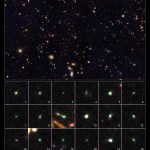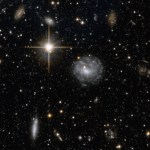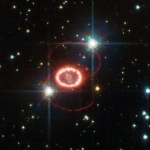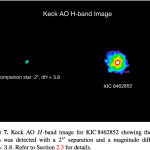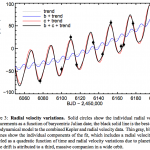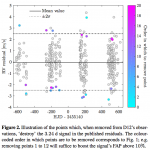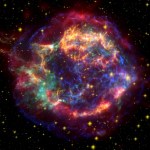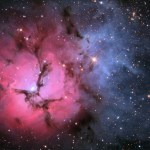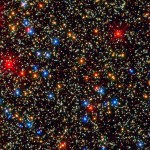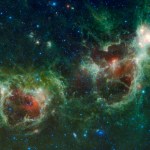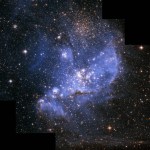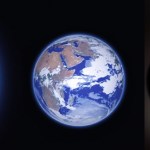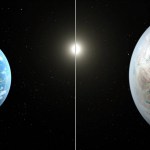Stars
"Some of them burn slow and long, like red dwarfs. Others -- blue giants -- burn their due so fast they shine across great distances, and are easy to see. As they start to run out of fuel, they burn helium, grow even hotter, and explode in a supernova. Supernovas, they're brighter than the brightest galaxies. They die, but everyone watches them go." -Jodi Picoult
One of the toughest things to predict is where our galaxy's next supernova will occur. The smart bet is that it will be a massive star, 20 times the Sun's mass or more, as more than 80% of the Universe's supernovae are of…
"The wonder is, not that the field of stars of so vast, but that man has measured it." -Anatole France
If you could gather 250 million times as much light as your eye, and improve your resolution by several orders of magnitude, you just might be able to see what the Hubble Space Telescope can. By extending down into the near-infrared, and combining those observations with that from other great observatories like Chandra and Spitzer, we can probe the star-formation history of the Universe.
Image credit: NASA, ESA, the GOODS Team and M. Giavalisco (STScI/University of Massachusetts), of a…
"We are stardust, we are golden,
We are billion year old carbon,
And we got to get ourselves back to the garden." -Crosby, Stills, Nash & Young
When Charles Messier first began cataloguing nebulae, even globular clusters, just a few tens of thousands of light years distant, weren’t resolvable into individual stars. But thanks to the Hubble Space Telescope, we can see individual stars in other galaxies many millions of light years away.
Image credit: NASA, ESA and T.M. Brown (STScI), of background galaxies seen through the disk of Andromeda.
In a series of images taken from 2004-…
"It’s becoming clear that in a sense the cosmos provides the only laboratory where sufficiently extreme conditions are ever achieved to test new ideas on particle physics. The energies in the Big Bang were far higher than we can ever achieve on Earth. So by looking at evidence for the Big Bang, and by studying things like neutron stars, we are in effect learning something about fundamental physics." -Martin Rees
Neutron stars are some of the most extreme objects in the Universe: a ball of neutrons a few kilometers in diameter, but with more mass than the entire Sun in them. Their magnetic…
"Think about it this way - a boomerang goes out and comes back to you if you throw it. If you throw it out at the universe, it will come back down to you on Earth." -J. B. Smoove
Give a planet a kick, and it goes into a more distant orbit around our star. Give it a hard enough kick, and it will reach escape velocity, leaving our Solar System forever. But if you gave it an almost hard enough kick, it would travel extremely far from the Sun, but it would eventually boomerang back towards the inner Solar System, with potentially disastrous, disruptive consequences. This applies to any…
"So numerous are the objects which meet our view in the heavens, that we cannot imagine a point of space where some light would not strike the eye;—innumerable stars, thousands of double and multiple systems, clusters in one blaze with their tens of thousands of stars, and the nebulae amazing us by the strangeness of their forms and the incomprehensibility of their nature, till at last, from the limit of our senses, even these thin and airy phantoms vanish in the distance." -Mary Fairfax Greig Somerville
The distant nebulae might appear to illuminate the night sky, but this neutral gas is…
"You will never be happy if you continue to search for what happiness consists of. You will never live if you are looking for the meaning of life." -Albert Camus
If you ask the average person where you can find new stars in our galaxy, they might (correctly) identify the Orion Nebula, a hotbed of star formation where thousands of new stars are presently being born. But at ~1,500 light years away, it's not the closest place where new stars are forming, not by a long shot.
Image credit: ESO/Digitized Sky Survey 2; Acknowledgement: Davide De Martin.
Instead, the southern hemisphere holds…
"Thou shalt not embarrass thyself and thy colleagues by claiming false planets." -Bill Cochran
Last year, Penn State astronomer Jason Wright made headlines by claiming that one of the stars being observed by NASA's Kepler mission might contain alien megastructures around it. The large dips in its light curve didn't make sense in the context of planets, and the star KIC 8462852 became the target of a great many follow-ups.
Image credit: Infrared: IPAC/NASA (2MASS), at left; Ultraviolet: STScI (GALEX), at right.
A binary companion was found, along with no signs of excess infrared emission or…
"Mars is much closer to the characteristics of Earth. It has a fall, winter, summer and spring. North Pole, South Pole, mountains and lots of ice. No one is going to live on Venus; no one is going to live on Jupiter." -Buzz Aldrin
When a planet passes in front of its star from our point of view, that transiting phenomenon can be detected as a dip in starlight. By surveying some 150,000 stars, the Kepler mission has detected close to 10,000 planetary candidates, many of which have been identified by the stellar wobble technique.
Image credit: NASA Ames.
But this "wobbling" also sometimes…
“You're on Earth. There's no cure for that.” -Samuel Beckett
In 2012, astronomers announced that the nearest star system to us, the Alpha Centauri system, possessed at least one exoplanet around it. A periodic signal that recurred just every 3.24 days was consistent with an Earth-sized exoplanet orbiting and gravitationally tugging on the second largest member of the star system: Alpha Centauri B.
Image credit: PHL @ UPR Arecibo, via http://phl.upr.edu/press-releases/aplanetarysystemaroundourneareststari….
That planet, named Alpha Centauri Bb, turns out not to actually be there. A…
"The two most common elements in the universe are hydrogen and stupidity." -Harlan Ellison
Shortly after the Big Bang, the Universe was filled with 99.99999993% hydrogen and helium, with the rest being lithium. But stars change everything, by fusing those elements -- the lightest ones -- into heavier ones, climbing the periodic table and enriching the Universe with its contents.
Image credit: NASA / JPL-Caltech.
After billions of years of star formation and nuclear fusion, a new 3rd most common element has emerged, and it isn’t carbon — formed from helium fusion — which only clocks in at…
"Truth is more valuable if it takes you a few years to find it." -Jules Renard
Of all the star-forming nebulae in our galaxy, the Trifid Nebula -- Messier 20 -- is thought to be the newest and youngest. Named "Trifid" for its threefold appearance, the blue reflection nebula, the red emission nebula, and the dark, star-forming dust lanes, it also bears a resemblance to the French tricolor flag.
Image credit: flickr user Marc Van Norden, via https://www.flickr.com/photos/mvannorden/8275065973/in/photostream/.
Because of the large number of young, hot stars still inside, the Trifid Nebula is…
When you take a large amount of mass and put it all together in a small volume of space, you fully expect gravity to do its thing, and eventually collapse things down as far as they'll go. You can imagine that for compact masses with large distances between them -- like planets in the solar system or stars in the galaxy -- this will take a very long time: longer than the age of the Universe.
Image credit: NASA/ESA and A. Feild, of the known globular clusters around the Milky Way.
But what about globular clusters: hundreds of thousands of stars collected in a spherical region of space…
“Birds sing after a storm; why shouldn’t people feel as free to delight in whatever sunlight remains to them?” -Rose Kennedy
It's a good thing that sunlight doesn't reach us simply from its moment of creation in the core of stars, otherwise we'd be bombarded with lethal gamma rays, rather than the life-giving UV, visible and infrared light we actually experience.
Image credit: Don Dixon of http://cosmographica.com/.
But that doesn't mean it isn't possible that the ultimate form of direct sunlight -- light from a nuclear reaction in the Sun -- to reach us, does it? Today's Ask Ethan focuses…
“What is history? An echo of the past in the future; a reflex from the future on the past.” -Victor Hugo
When stars are born of a certain mass -- between about 10 and 40 times the mass of the Sun -- they can evolve into yellow supergiants when they burn through the hydrogen in their cores. As the outer layers expand, cool, contract, heat up, and pulse in this fashion, they can occasionally be blown off to form a gaseous cloud surrounding the star.
Image credit: ESA/Hubble & ESO.
These Cepheid variable stars have been known and studied for over a hundred years, and vary tremendously in…
“Aristotle taught that stars are made of a different matter than the four earthly elements — a quintessence — that also happens to be what the human psyche is made of. Which is why man’s spirit corresponds to the stars. Perhaps that’s not a very scientific view, but I do like the idea that there’s a little starlight in each of us.” -Lisa Kleypas
We like to think of the stars as fixed, as their position doesn't perceptibly change from night-to-night or even year-to-year. Not only that, but their brightness and color doesn't appear to change, either. But is that actually true, or is that only…
“That, then, is loveliness, we said,
Children in wonder watching the stars,
Is the aim and the end.
Being but men, we walked into the trees.” -Dylan Thomas
Yet when you look at the night sky, it isn't watching the stars that reveals all of the Universe's secrets, nor by looking with what you can see with your eyes. Looking beyond what visible light can teach us often reveals a whole Universe of wonder that we'd never see otherwise.
Image credit: NASA/JPL-Caltech/WISE Team.
Looking in infrared light, NASA's Wide-field Infrared Survey Explorer (WISE) reveals the intricate structure behind…
“To be is to be the value of a variable.” –Willard Van Orman Quine
Those constant, fixed points of light in the night sky -- the stars -- turn out not to be so constant if you looked with great precision at them. A star like our Sun varies in brightness, periodically, by about 0.1% over the span of a few years, but many stars vary by 99% or more from brightest to dimmest.
Image credit: British Astronomical Association Variable Star Section, via http://www.britastro.org/vss/.
For centuries, we knew of only a handful of these objects, yet now they're known to be commonplace. What…
“As the blackness of the night recedes so does the nadir of yesterday. The child I am forgets so quickly.” -Sylvia Ashton-Warner
While the night sky is littered with thousands of points of light -- the stars visible to the naked eye -- we know that beyond what human perception can see, there are hundreds of billions of stars in our galaxy alone, and hundreds of billions of galaxies in the observable Universe. Yet every star that ever has shone or will shine will someday run out of fuel and die.
Image credit: NASA/ESA and The Hubble Heritage Team (AURA/STScI), via https://www.…
“You can spend too much time wondering which of identical twins is the more alike.” -Robert Brault
Earlier today, NASA announced the "most Earth-like exoplanet yet," a planet just 60% larger in radius than our own, orbiting a star of the same spectral class as our Sun and with an almost identical orbital period: 385 days.
Image credit: NASA/JPL-CalTech/R. Hurt.
But is this really the most Earth-like planet we've discovered? It's significantly larger and five times as massive, and may actually be more like Neptune than like Earth. In fact, other properties may be much more important if we…

